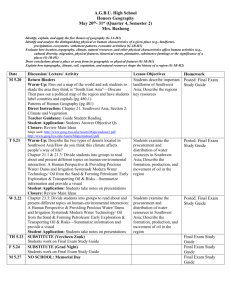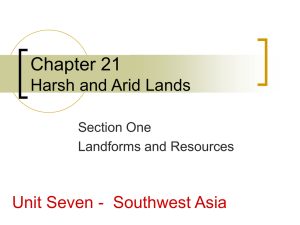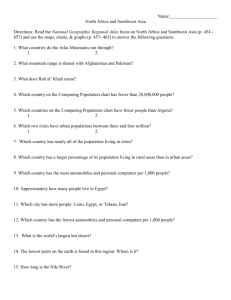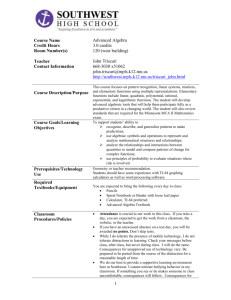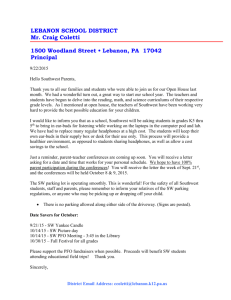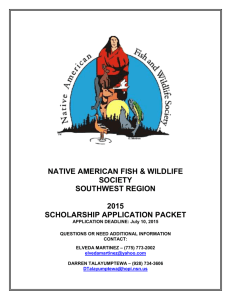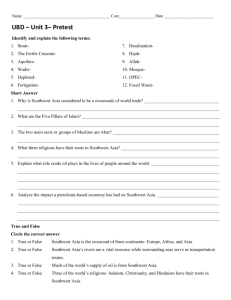ENV 373 - nau.edu
advertisement
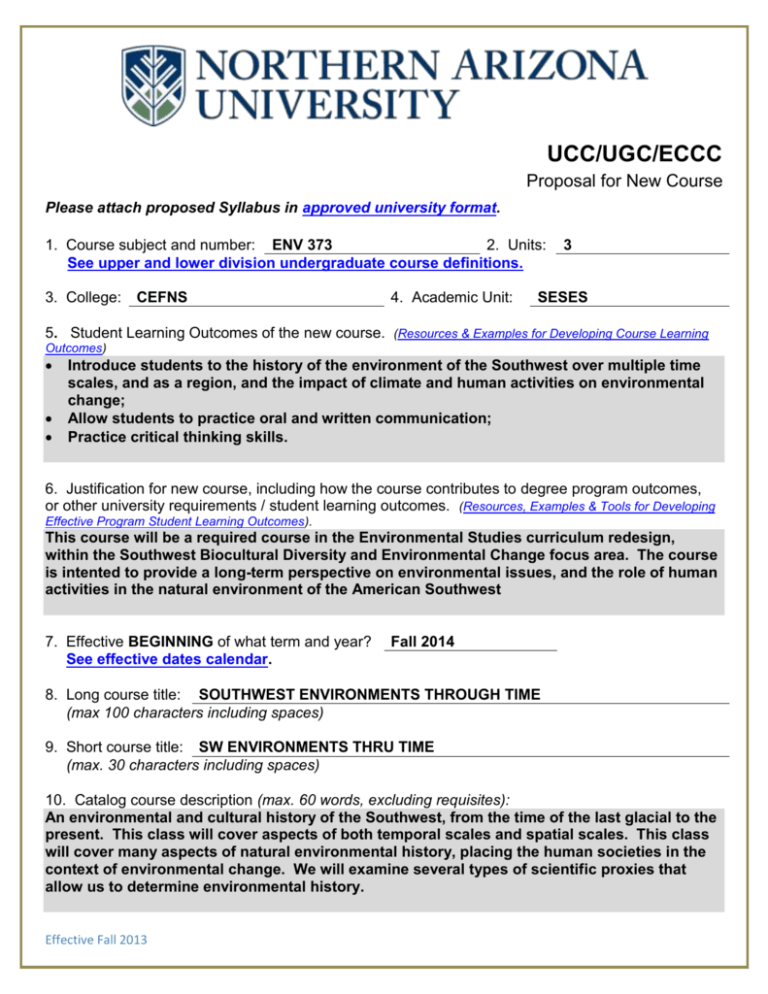
UCC/UGC/ECCC Proposal for New Course Please attach proposed Syllabus in approved university format. 1. Course subject and number: ENV 373 2. Units: See upper and lower division undergraduate course definitions. 3. College: CEFNS 4. Academic Unit: 3 SESES 5. Student Learning Outcomes of the new course. (Resources & Examples for Developing Course Learning Outcomes) Introduce students to the history of the environment of the Southwest over multiple time scales, and as a region, and the impact of climate and human activities on environmental change; Allow students to practice oral and written communication; Practice critical thinking skills. 6. Justification for new course, including how the course contributes to degree program outcomes, or other university requirements / student learning outcomes. (Resources, Examples & Tools for Developing Effective Program Student Learning Outcomes). This course will be a required course in the Environmental Studies curriculum redesign, within the Southwest Biocultural Diversity and Environmental Change focus area. The course is intented to provide a long-term perspective on environmental issues, and the role of human activities in the natural environment of the American Southwest 7. Effective BEGINNING of what term and year? See effective dates calendar. Fall 2014 8. Long course title: SOUTHWEST ENVIRONMENTS THROUGH TIME (max 100 characters including spaces) 9. Short course title: SW ENVIRONMENTS THRU TIME (max. 30 characters including spaces) 10. Catalog course description (max. 60 words, excluding requisites): An environmental and cultural history of the Southwest, from the time of the last glacial to the present. This class will cover aspects of both temporal scales and spatial scales. This class will cover many aspects of natural environmental history, placing the human societies in the context of environmental change. We will examine several types of scientific proxies that allow us to determine environmental history. Effective Fall 2013 11. Will this course be part of any plan (major, minor or certificate) or sub plan (emphasis)? Yes If yes, include the appropriate plan proposal. Environmental Studies BA/BS. No 12. Does this course duplicate content of existing courses? Yes No If yes, list the courses with duplicate material. If the duplication is greater than 20%, explain why NAU should establish this course. 13. Will this course impact any other academic unit’s enrollment or plan(s)? Yes No If yes, describe the impact. If applicable, include evidence of notification to and/or response from each impacted academic unit 14. Grading option: Letter grade Pass/Fail Both 15. Co-convened with: 14a. UGC approval date*: (For example: ESE 450 and ESE 550) See co-convening policy. *Must be approved by UGC before UCC submission, and both course syllabi must be presented. 16. Cross-listed with: (For example: ES 450 and DIS 450) See cross listing policy. Please submit a single cross-listed syllabus that will be used for all cross-listed courses. 17. May course be repeated for additional units? 16a. If yes, maximum units allowed? 16b. If yes, may course be repeated for additional units in the same term? Yes No Yes No 18. Prerequisites: If prerequisites, include the rationale for the prerequisites. 19. Co requisites: If co requisites, include the rationale for the co requisites. 20. Does this course include combined lecture and lab components? Yes If yes, include the units specific to each component in the course description above. 21. Names of the current faculty qualified to teach this course: No R. Scott Anderson, PhD, Diana Elder PhD 22. Classes scheduled before the regular term begins and/or after the regular term ends may require additional action. Review “see description” and “see impacts” for “Classes Starting/Ending Outside Regular Term” under the heading “Forms” http://nau.edu/Registrar/Faculty-Resources/Schedule-of-Classes-Maintenance/. Effective Fall 2013 Do you anticipate this course will be scheduled outside the regular term? Yes No 23. Is this course being proposed for Liberal Studies designation? If yes, include a Liberal Studies proposal and syllabus with this proposal. Yes No 24. Is this course being proposed for Diversity designation? If yes, include a Diversity proposal and syllabus with this proposal. Yes No Answer 22-23 for UCC/ECCC only: FLAGSTAFF MOUNTAIN CAMPUS Scott Galland Reviewed by Curriculum Process Associate 01/30/2014 Date Approvals: Department Chair/Unit Head (if appropriate) Date Chair of college curriculum committee Date Dean of college Date For Committee use only: UCC/UGC Approval Date Approved as submitted: Yes No Approved as modified: Yes No EXTENDED CAMPUSES Reviewed by Curriculum Process Associate Effective Fall 2013 Date Approvals: Academic Unit Head Date Division Curriculum Committee (Yuma, Yavapai, or Personalized Learning) Date Division Administrator in Extended Campuses (Yuma, Yavapai, or Personalized Learning) Date Faculty Chair of Extended Campuses Curriculum Committee (Yuma, Yavapai, or Personalized Learning) Date Chief Academic Officer; Extended Campuses (or Designee) Date Approved as submitted: Yes No Approved as modified: Yes No Effective Fall 2013 Southwest Environments Through Time ENV 373 General Information: College of Engineering, Forestry & Natural Sciences School of Earth Sciences and Environmental Sustainability Semester offered: Spring 2014 Clock and Credit Hours: 11:10-12:25 AM, 3 credit hours Location: PS 111 Instructor: R. Scott Anderson, PhD Office Address: PS 138 Office Hours: M 1 – 4, or by appointment Email: Scott.Anderson@nau.edu Course Prerequisites: None Course Description and Objective: In Southwest Environments Through Time, you will be introduced to the environmental and cultural history and studies of the Southwest, from the time of the last glacial to the present. This class will cover aspects of both temporal scales (approximately the last 20,000 years to the present) and spatial scales (encompassing what we now know as the Southwestern United States and northern Mexico). We will cover many subjects of natural environmental history, placing the human societies of the region in the context of environmental change. We will examine several types of proxies (a proxy is a substitute) that allow us to determine environmental history. For instance, fossil pollen is a proxy for former vegetation and climate; tree-rings can also be a proxy for former climates or former fires. It is hoped that by examining past environmental issues, the student will obtain a unique perspective on important environmental issues of today. Liberal Studies Information: 1. Mission of Liberal Studies: This course fits essentially all of the missions of the Liberal Studies requirements. The course content challenges students to consider not only the spatial scale of environmental change but also the temporal scale. Too often students consider environmental change to be limited to effects since the beginning of the Industrial Revolution, when in fact environmental change has been constant through time. In addition, this course examines the relationship between human impact of the Southwest, from Native American through Euro-, Asianand African-American impacts through time on the natural environment. The impact of former climates and human activities has determined the environment we have today, and only by understanding this environmental history will we be able to evaluate the range of variability in natural and cultural systems for guidance into the future of both the natural and cultural environments of the Southwest. Effective Fall 2013 2. Distribution Block: This course fits most naturally into the Science Distribution Block (evaluation of the natural environment of the Southwest), but includes some aspects of Cultural Understanding. 3. This is a course that explores the changes in the environment of the Southwest over millennia to the most recent decades with a goal of providing a broad perspective on “how we got to where we are”. The subject matter will integrate scientific, historic and cultural aspects of the Southwest in order to provide an interdisciplinary examination of the natural environment of the region with changing climate and human land-use through time. This upper division Liberal Studies course will occur in the Science Distribution Block. The stated mission of the Liberal Studies Program is to prepare students to live responsible, productive, and creative lives as citizens of a dramatically changing world. To accomplish the mission, this course fits the criteria of NAUs Liberal Studies Program in that it challenges a student’s concept of the natural world and the place of human culture within that world. The student will gain a deeper understanding of the impact of climate and cultural change on plant communities of the Southwest, and by extension the broader impact of these factors on the Earth as a whole. By taking this class students will acquire not only a broad range of knowledge on the subject but also be required to practice essential skills, such as critical thinking and effective interdisciplinary writing, as well as others. Assessment of Student Learning Outcomes: Course learning outcomes identify (1) what is learned; (2) how a student demonstrates that learning, and (3) the quality with which the learing is demonstrated. (1) The course has been designed to introduce students to the history of the environment of the Southwest over multiple time scales, and as a region, to the impact of climate and human activities on environmental change. It is important in this regard that the student connects the history of environmental change in the past with more recent environmental changes in the Southwest. (2) The student will demonstrate what has been learned by both written (two) and oral (one) assignments. The written assignments include a 1500-word report on a subject in the Southwest that integrates the natural environment and ecosystem disturbance. The second written assignment is a field trip report from the student’s self-guided field trip of a local natural or cultural site (see below). The oral report consists of a 5-minute presentation on report # 1. (3) The student will be evaluated by their response on a pre- and post-class slide show; by their performance on the exams and quizzes, by the two written reports and the single oral report. The oral report will in addition be peer-reviewed. Methods of Assessment: As stated above, student learning outcomes will be assessed by a combination of pre- and post-course evaluations, as well as three exams, weekly quizzes, written and oral assignments. The pre- and post-course evaluations will be particularly important, and will consist Effective Fall 2013 of a slide show of dominant themes to be covered in the course in which students are required to write their impressions of the theme. It is expected that students will know little of the true meaning of the theme in the pre-course evaluation, but will be completely conversant about the theme in the post-course evaluation. Of course, assessment is straightforward for the quizzes and exams. A rubric will be used for assessing the student reports and oral presentation much like we use in ENV 490C (Senior Seminar Capstone course). Timeline for Assessment: Pre- and post-course assessment will be early and late, respectively, in the course. Other assessment follow in the manner of the syllabus (see below). Course Structure/Approach: The course will be lecture and discussion based, with class discussion being strongly encouraged. The subject encompasses a diversity of topics. Lecture notes will be available on the class Blackboard LEARN website by the morning of the lecture. I suggest that you download them to your computer if you have access to one, and bring that to class. Exams will be multiple choice and short essay format. There will be three exams as discussed below. Class Attendance and Quizzes: Attendance will be taken each day. Students are expected to come to class prepared to discuss the topic of the day, which means that students are expected to read the required readings for that day before each class. A short quiz on the readings will be given approximately once per week. You will be allowed to drop the 2 lowest quiz grades. Research documents that students that attend class regularly and do the readings nearly always do better than those that do not. And this is especially true for taking quizzes! Exams: Missing an exam is highly discouraged. There will be 3 exams in this course, and they are scheduled on this syllabus. These will be in-class exams, with the class period before the exam consisting of a review session. Students will submit five questions for discussion prior to each review session. Each exam is worth 50 points, and will be a combination of multiple choice and short answer questions. Writing Assignments: There will be two writing assignments in this course. The first writing assignment will be a 1500-word paper on some aspect related to topics in this course. This paper will provide you with a chance to delve deepter into a subject that interests you. More information will be provided on this in the next few weeks. The second writing opportunity will come associated with the self-sponsored field trip described below. Field Trip: There is so much to see in the Southwest having to do with natural and cultural history. But there will be no organized fieldtrip for this class. Instead, the student will be responsible for designing their own field trip (“the self-sponsored field trip”) that will be to a pertinent environmental or prehistoric or historic site in or near Flagstaff. Many possibilities exist for this trip, including Wupatki, Sunset Crater, Walnut Canyon, Montezuma Well, Montezuma Castle, Tuzigoot, Canyon de Chelley, and Navajo National Monuments; Grand Canyon National Park; Riordan Mansion State Historic Park, Arizona Historical Society – Pioneer Museum; Museum of Northern Arizona; Homolovi Ruins; etc., and many, many others. In the past many students have chosen to visit a significant site on one of their Spring Break excursions. Effective Fall 2013 If you would like to visit some other place of interest, just ask. But please check with me first. This need not last the entire day, but should be some portion of a day, long enough to get to know the reason for the existence of the site. In other words, spend a couple of hours at the site learning about its environment and prehistoric- or modern human-environment interactions. There are three things that you must do for this assignment: (1) consult with Dr. Anderson about your plans BEFORE you go to make sure that the site is acceptable. If you are already travelling, and see some really interesting site, spend some time there and then come to see me. (2) Turn in a 2-page, typed, double-spaced essay describing what you saw and explicitly linking it to some lecture topic of the course. Describe the general environment (desert, mountain, etc.), and then be more specific about the actual site itself (i.e., is it in a riparian zone, etc.). Describe the dominant plants there, using common and Latin names. For any cultural or historical site, discuss the dates of the site, and how the dating was done, where and how food and water was obtained, and why the people left. Include at least two citations, only one of which can be from a website. (3) Your report must include a photo of you at the site, so make it obvious that you were there. Small groups of students may travel together, but each student must do the consultation and essay independently. Textbook Readings and Required Materials: There is no textbook for this course because no single book covers all of the varied content. Instead of a single text, there will be required readings for each class. The readings will be available for the student to download from the class BBLearn website. If you have any problem downloading the readings, please let me know. Course Outline with Readings: Week Topic Readings “Background on the Southwest” 1a (T Jan 14) 1b (Th Jan 16) Introduction – Defining the Southwest and Pre-Class Eval Geology and Physiography of the Southwest Sheppard et al. (2008); Byrkit (1992, to p. 273) USGS (The Great Ice Age) http://www2.nau.edu/rcb7/coloradoplateau.html http://geology.com/state-map/arizona.shtml 2a (T Jan 21) 2b (Th Jan 23) Climate – General circulation features Climate – the Southwest and the Colorado Plateau Class notes only Gutzler (1996); Hereford (2002); http://www.elnino.noaa.gov/index.html 3a (T Jan 28) 3b (Th Jan 30) Dating Techniques – Aging Ancient records Techniques in Paleoecology and paleo-Climate Analysis Robinson (1976); NatGeo (2001); Jull (2007) 4a (T Feb 4) 4b (Th Feb 6) Southwest Ecosystems – Deserts Southwest Ecosystems – Mountains Phillips et al. (1989) Phillips et al. (1989) 5a (T Feb 11) 5b (Th Feb 13) In Class Review for Exam – “Background on the Southwest” Exam # 1 – Background on the Southwest Elias (2007); Seppa (2007) “Deep Time Environmental Issues” 6a (T Feb 18) Effective Fall 2013 Deep Time History - Early Humans & the Martin & Burney (1999); Donlan (2006) Pleistocene Overkill Hypothesis 6b (Th Feb 20) 7a (T Feb 25) 7b (Th Feb 27) 8a (T Mar 4) 8b (Th Mar 6) Guthrie (2006); Graceful gazelle http://www.hcn.org/issues/213/10797 LaBrea Tarpits http://www.tarpits.org/ http://instaar.colorado.edu/QGISL/bering_land_bridge/ Deep Time History – Glaciers, Lakes & Streams TBA Deep Time History – Vegetation Change in SW Deserts Deep Time History – Vegetation Change in SW Uplands Elias (2007); Anderson et al. (2000) Anderson (1993); Anderson et al. (2008) Human Settlement Patterns – The Holocene of the Southwest Human Settlement Patterns – The last 2000 years in the Southwest Cordell (1984) “The Paleo-Indian Period” Cordell (1984) “The Archaic Period” 9a (T Mar 11) Native American Environmental Impacts Betancourt & Van Devender (1981); Betancourt et al. (1986) 9b (Th Mar 13) Northern Mexico Paleoenvironments Towner (1999) 10 SPRING BREAK 11a (T Mar 25) 11a (Th Mar 27) In Class Review for exam – “Deep Time Environmental Issues” Exam # 2 – Deep Time Environmental Issues “Transition from Deep Time to Present Time” 12a (T Apr 1) Europeans Arrive http://en.wikipedia.org/wiki/Juan_Bautista_de_Anza http://www.desertusa.com/mag99/sep/papr/escalante.html 12b (Th Apr 3) Southwest Forest Fire History Anderson et al. (2008) 13a (T Apr 8) 13b (Th Apr 10) Impact of Grazing in the Southwest (Dr. Tom Sisk) Water Issues – Impact of Historic Droughts Loeser et al. (2007); Sisk reading Breshears et al. (2005) 14a (T Apr 15) Water Issues – Historic & Prehistoric Flooding and Flow Regulation Harvey and Pederson (2011) 14b (Th Apr 17) Repeat Photography and Documenting Recent Change 15a (T Apr 22) 15b (Th Apr 24) Global Change in the Southwest Global Change in the Southwest 16a (T Apr 29) 16b (Th May 1) Connecting the Past to the Present and Future Lecture Notes In Class Review – “Transition from Deep to Present Time” 17a (Th May 8) FINAL EXAM (10:00 – Noon) TBA TBA Grading System: Based upon the above, the following credit will be given to each assignment: Pre-Course Evaluation Midterm Exam # 1: Midterm Exam # 2: Final Exam (# 3) Review Session Questions Semester Paper: Oral Presentation Peer-evaluations Field Trip Report: Effective Fall 2013 5 pts 50 pts 50 pts 50 pts 15 pts 25 pts 20 pts 10 pts 25 pts Quizzes Class Evaluation Post-Course Evaluation General Participation Total 25 pts 10 pts 5 pts 10 pts 300 pts The grading scale will be as follows: 100% - 90% = A; 89% - 80% = B; 79% - 70% = C; 69% - 60% = D; below 60% = F. Course policies: It is my responsibility to teach, and your responsibility to learn. I expect you, as a student, will fully participate in this class. Makeup tests are only allowed in extreme circumstances, which may be worked out between instructor and student on a case-by-case basis. As you present the results of your work, it is natural that you will include materials, data, interpretation etc., which, although part of the larger project in which you participated, are not your own work. It is critical to acknowledge when materials you present are not your own. All scientists use materials developed by others, just make sure that when you do, it is well cited. University policies: SAFE ENVIRONMENT POLICY NAU’s Safe Working and Learning Environment Policy seeks to prohibit discrimination and promote the safety of all individuals within the university. The goal of this policy is to prevent the occurrence of discrimination on the basis of sex, race, color, age, national origin, religion, sexual orientation, disability, or veteran status and to prevent sexual harassment, sexual assault or retaliation by anyone at this university. You may obtain a copy of this policy from the college dean’s office or from the NAU’s Affirmative Action website http://home.nau.edu/diversity/. If you have concerns about this policy, it is important that you contact the departmental chair, dean’s office, the Office of Student Life (928-523-5181), or NAU’s Office of Affirmative Action (928-523-3312). STUDENTS WITH DISABILITIES If you have a documented disability, you can arrange for accommodations by contacting Disability Resources (DR) at 523-8773 (voice)or 523-6906 (TTY), dr@nau.edu (e-mail)or 928-523-8747 (fax).Students needing academic accommodations are required to register with DR and provide required disability related documentation. Although you may request an accommodation at any time, in order for DR to best meet your individual needs, you are urged to register and submit necessary documentation (www.nau.edu/dr) 8 weeks prior to the time you wish to receive accommodations. DR is strongly committed to the needs of student with disabilities and the promotion of Universal Design. Concerns or questions related to the accessibility of programs and facilities at NAU may be brought to the attention of DR or the Office of Affirmative Action and Equal Opportunity (523-3312). ACADEMIC INTEGRITY The university takes an extremely serious view of violations of academic integrity. As members of the academic community, NAU’s administration, faculty, staff and students are dedicated to promoting an atmosphere of honesty and are committed to maintaining the academic integrity essential to the education process. Inherent in this commitment is the belief that Effective Fall 2013 academic dishonesty in all forms violates the basic principles of integrity and impedes learning. Students are therefore responsible for conducting themselves in an academically honest manner. Individual students and faculty members are responsible for identifying instances of academic dishonesty. Faculty members then recommend penalties to the department chair or college dean in keeping with the severity of the violation. The complete policy on academic integrity is in Appendix G of NAU’s Student Handbook http://www4.nau.edu/stulife/handbookdishonesty.htm. Effective Fall 2013
